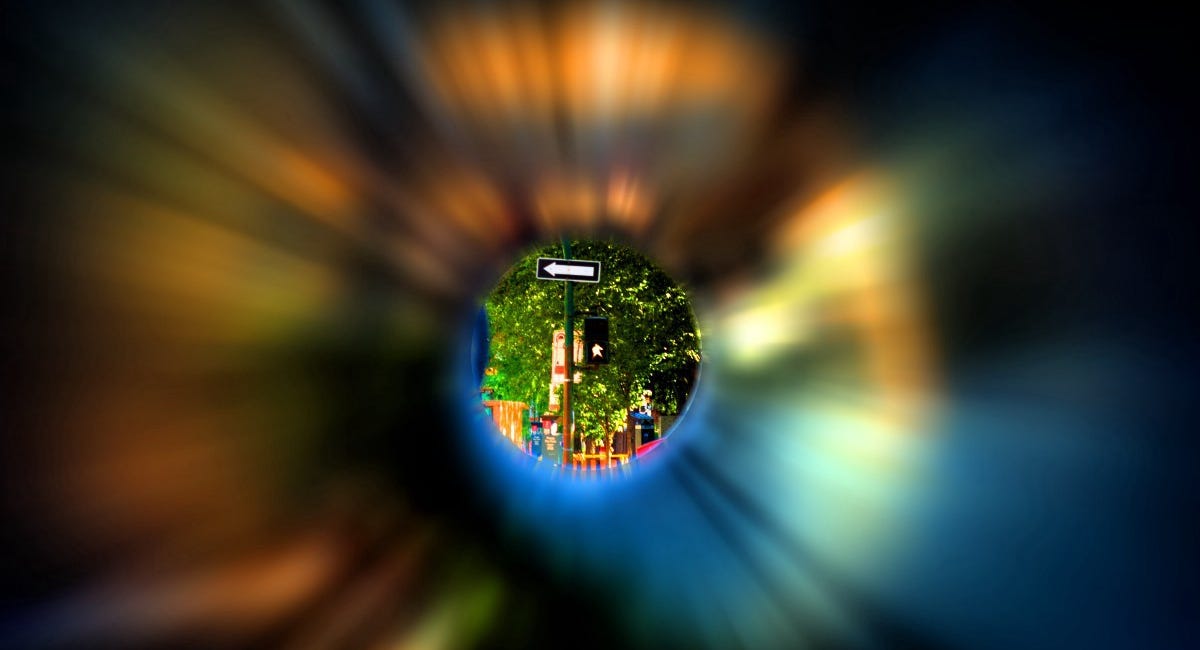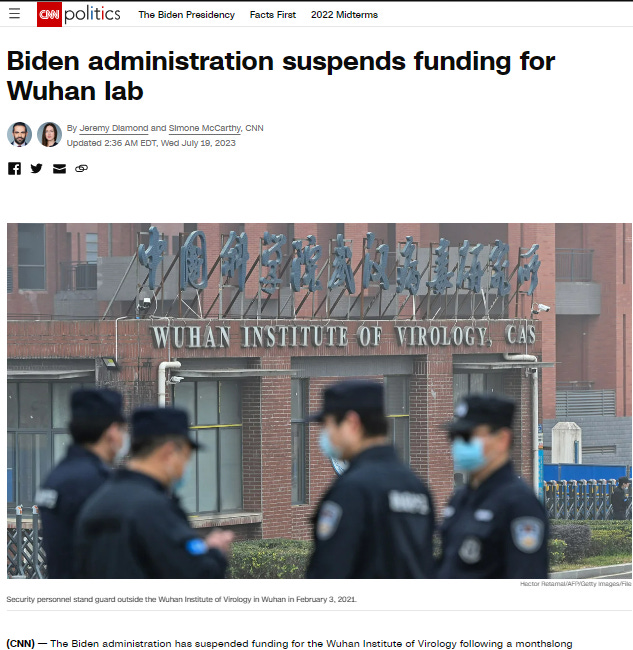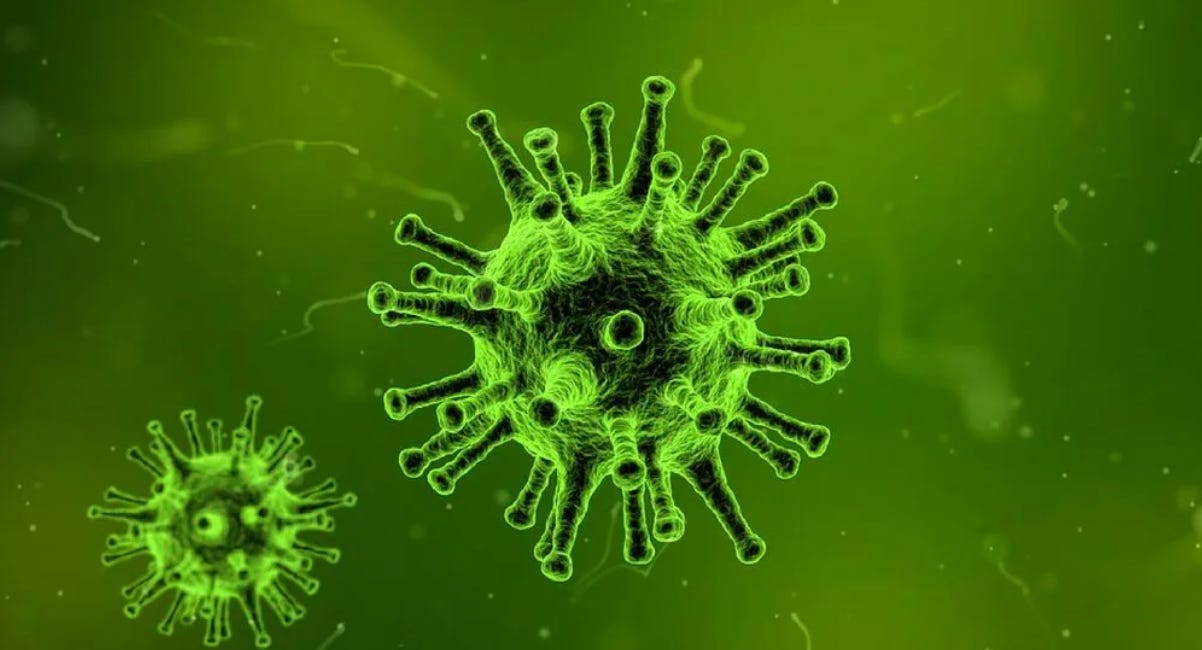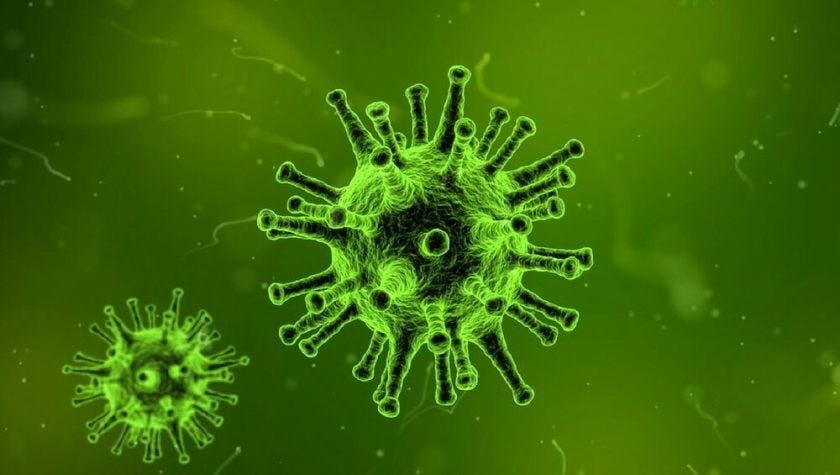Scientists Silencing Science: The True Harm in Dismissing the Lab-Leak Hypothesis
Ignoring the Lab-Leak Hypothesis Undermines Science and Public Health. Of Course Individual Scientists Working on Pathogens Must be Held Accountable with Oversight to Discourage Lab Leak Pandemics
On August 1, 2024, a group of 41 authors published an article(1) asserting that promoting the lab-leak hypothesis for the origins of SARS-CoV-2 is harmful, branding such exploration as "anti-science" and devoid of evidence. These authors, many of whom hold significant influence in the field of virology and who would likely see career changes if gain-of-function research is canceled, sought to reinforce the prevailing narrative of a natural zoonotic origin, dismissing the lab-leak theory as a dangerous distraction. However, this stance is not merely a rejection of an alternative hypothesis—it is a calculated attempt to silence debate and undermine the fundamental principles of scientific inquiry.
The implications of their stance are not just analytically superficial—they are dangerous. By discouraging the exploration of all possible origins of SARS-CoV-2, society would risk ignoring critical evidence, undermining the public's trust in scientific integrity, and, most gravely, leaving the world vulnerable to future pandemics born of the same potential laboratory failures that this hypothesis seeks to investigate.
This editorial will lay bare the selective reasoning, circumstantial dismissals, and political biases permeating the "Harms" article. It will expose the dangerous fallacy of equating healthy scientific skepticism with denialism and illustrate why the lab-leak hypothesis is not only viable but essential to explore if we are to fully understand the origins of COVID-19 and prevent future global health crises.
In dismissing the lab-leak hypothesis, the authors overlook critical historical precedents that demand attention. Lab accidents and leaks are not speculative fears; they are documented and oft-repeated realities. From the 1979 Sverdlovsk anthrax leak to the multiple SARS escapes in China during the early 2000s, history is replete with examples of pathogens escaping even the most secure facilities. These incidents underscore the vulnerability of high-level biosafety labs and the potential for catastrophic consequences when pathogens breach containment. The Wuhan Institute of Virology (WIV), located just miles from the initial outbreak of SARS-CoV-2, has a documented history of safety lapses. The proximity of WIV to the epicenter of the pandemic, combined with its involvement in gain-of-function (GoF) research, makes it imperative to thoroughly investigate this possibility.
Furthermore, the authors’ assertion that no evidence supports the lab-leak hypothesis is misleading and incomplete. A growing body of circumstantial evidence suggests that SARS-CoV-2 may have been artificially enhanced to increase its transmissibility in humans. The presence of the SARS-CoV-2 specific and unique furin cleavage site—a genetic feature uncommon in coronaviruses like SARS-CoV-2—raises significant questions about the virus’s origin. Additionally, the virus's superfitness to human hosts, described by former CDC Director Robert Redford as evidence that the virus had evolved "too far, too fast," further supports the need to explore all potential origins, including a lab-based scenario. This is also evidence. Ignoring these anomalies in favor of a single narrative is not only scientifically irresponsible but also potentially dangerous, as it prevents us from learning the necessary lessons to prevent future pandemics.
In addition to ignoring the historical precedent of lab leaks, the 41 authors fail to address the suppression and manipulation of crucial data that has marred the investigation into the origins of SARS-CoV-2. For instance, early genetic sequences of the virus were deleted from public databases, only to be later recovered by independent researchers. This act of data suppression raises serious concerns about transparency and accountability within the scientific community. If we are to trust the conclusions drawn about the virus’s origins, the process must be open and transparent, allowing for all hypotheses to be rigorously tested and debated.
Moreover, the conflicts of interest among key figures “investigating” SARS-CoV-2’s origins cannot be overlooked. Prominent scientists, such as Dr. Anthony Fauci, have been implicated in funding and supporting gain-of-function research, which could have led, and most think likely did lead to the creation of SARS-CoV-2. The potential bias introduced by these financial and professional ties, and their specific secretive behaviors on the now-infamous phone call casts doubt on the objectivity of their conclusions. To dismiss the lab-leak hypothesis without fully exploring these conflicts is to undermine the integrity of the scientific process. We must ensure that all potential sources of bias are addressed if we accept that the goal of science is to attempt to arrive at the truth.
The "Harms" article’s dismissal of the lab-leak hypothesis also overlooks the growing global calls for transparency and accountability. The Biden Administration’s decision in 2023 to cut funding to the Wuhan Institute of Virology due to its refusal to provide critical safety documentation clearly indicates that concerns about the lab’s practices are not unfounded. This action, alongside similar calls from international organizations for an independent and thorough investigation, demonstrates that the lab leak theory is taken seriously by credible entities around the world.
Furthermore, the 41 authors of the "Harms" article fail to acknowledge the contributions of independent researchers and institutions like IPAK, which have played a crucial role in keeping the lab-leak hypothesis in the public discourse. We were among one of the first to propose the lab-leak theory as early as January 2020, based on sound scientific reasoning and the available data at the time. Our specific hypothesis even earned a rapid rebuttal in March 2020(2) from Chinese scientists who claimed (incorrectly) that pShuttle-SN was not a vector technology. These employees of the CCP tried to assert that the sequence of interest we found was found in other coronaviruses (using sequence alignment). They did not, however, say how and why pShuttle-SN, a generic vector technology, would, off-the-shelf, contain the SARS-CoV spike sequence.
Contrary to the Chinese scientists’s (Chinese Academy of Sciences, Beijing Institute of Pharmacology and Toxicology) critique of the IPAK evidence, the pShuttle-SN is, in fact, a generic vector, not specifically designed for SARS-CoV, and it was used in various genetic engineering applications, including those involving adenovirus-based expression systems. It would not inherently contain a SARS-CoV spike gene unless it was specifically engineered to do so in a separate experiment. The authors' assertion that pShuttle-SN is not a vector is incorrect, and reflects a misunderstanding of its use and function in molecular biology (see product page for pShuttle-SN). The critique appears to have been an attempt to muddle and confuse the consideration of the evidence.
Since then, many efforts of independent voices have been vital in ensuring that the investigation into the origins of SARS-CoV-2 continues and remains comprehensive and unbiased, countering the attempts to dismiss this critical line of inquiry prematurely.
The "Harms" article’s attempt to dismiss the lab-leak hypothesis as mere conspiracy theory fails to recognize the fundamental role of skepticism and debate in scientific progress. They wrote:
“(This discourse) also stokes the flames of an anti-science, conspiracy-driven agenda, which targets science and scientists even beyond those investigating the origins of SARS-CoV-2.”
The use of the term conspiracy is now known to be an attempt to discredit even credible ideas and facts; the concept that individual scientists are “targeted” betrays self-victimization, a well-known tactic of guilty suspects in criminal investigations to attempt to throw investigators off-track or to convince investigators of their innocence. No one need target any individual to look back at the long history of deadly pathogen escapes from laboratories and understand that WIV and about a dozen other labs around the world were performing gain-of-function research on coronaviruses, including those found in the wild and brought into the lab. That history is completely known to us, and for scientists to play the victim instead of addressing the concerns before us serves only to obfuscate.
Science thrives on challenging established ideas, especially when evidence points to plausible alternatives. The lab-leak theory is scientifically plausible and addresses the unexplained anomalies of SARS-CoV-2's origins, such as its rapid adaptation to human hosts. To dismiss these questions as “anti-science” is to misunderstand or misrepresent the core principles that drive scientific inquiry.
Moreover, the article’s failure to adequately engage with the molecular and genetic evidence supporting the lab-leak hypothesis reveals a significant oversight. The unusual genetic features of SARS-CoV-2, including the furin cleavage site and its exceptional binding affinity to human ACE2 receptors, suggest a more complex origin than simple zoonotic transfer. Multiple independent researchers have highlighted these features who argue that such traits are more consistent with laboratory manipulation or accelerated evolution in a lab setting than with a natural spillover event. Ignoring this evidence does a disservice to the scientific community’s responsibility to explore all potential origins of the virus fully.
The authors of the "Harms" article seem to base their position on an absence of evidence, knowing full well that data from China on this question will eternally be incomplete. Inconceivably, the World Health Organization placed Ecohealth Alliance, the broker of the funding between NIAID and WIV, in an investigative position, a move so brazenly corrupted that the WHO had to do a “re-do” of the investigation to try to save face. It did not work; their charade led to no new data and they failed to convince anyone.
The authors also exhibit a concerning double standard in evaluating evidence of the two hypotheses. While they demand an impossibly high level of proof to consider the lab-leak hypothesis, they appear content to accept the zoonotic spillover hypothesis based on circumstantial evidence, speculative connections, and this absence of evidence where none can be expected. That is not sound reasoning. This asymmetry not only skews the investigation but also raises questions about the motivations behind their insistence on dismissing the lab leak theory.
By prematurely declaring the zoonotic origin as the most likely scenario, without the thorough examination that a lab-leak hypothesis requires, the authors undermine the scientific process that relies on the balanced and unbiased consideration of all available evidence. Their willingness to uncritically accept China's refusal to provide critical information and their uneven application of evidentiary standards highlight a broader issue of bias that threatens to derail the objective pursuit of truth. To prevent future pandemics, all hypotheses must be subjected to the same rigorous scrutiny without prematurely closing the door on any plausible explanation or factor.
For the long-term health of science, it is also essential to address the broader consequences of dismissing the lab leak hypothesis without thorough investigation. Refusing to explore it hypothesis fully sends a dangerous message to the global scientific community: certain lines of inquiry are off-limits if they challenge powerful interests or existing narratives. This not only stifles scientific progress but also undermines the efficient functioning of the institutions that are supposed to safeguard public health. As a result, they are now suffering from a well-earned all-time low in public trust.
Evidence that Evidence Matters: The Case of H5N1 Lab Accidents and Genetic Investigations
The discussion surrounding the origins of SARS-CoV-2 must be grounded in a thorough examination of evidence, drawing lessons from historical and recent events. Two significant cases—the H5N1 lab accident in 2019 at the University of Wisconsin and the ongoing analysis of the H5N1 Clade 2.3.4.4b—highlight the critical importance of transparency and rigorous investigation in the field of virology. These cases underscore why dismissing or downplaying potential evidence of laboratory origins can have far-reaching consequences for public health and scientific integrity.
The 2019 H5N1 Lab Accident: Evidence Trumps Narrative
In December 2019, a serious incident occurred at the University of Wisconsin’s Influenza Research Institute, where an H5N1 virus had been modified through gain-of-function (GoF) research to become transmissible among ferrets, an animal model used to predict flu virus behavior in humans. Led by the renowned virologist Yoshihiro Kawaoka, this research aimed to understand how H5N1 might evolve in nature. However, the experiment raised significant concerns due to the potential for accidental release of a highly transmissible and dangerous pathogen.
During the experiment, a researcher’s respirator hose detached, allowing them to breathe potentially contaminated air. Although the incident did not result in human infection, it exposed serious lapses in safety protocols, including a failure to report the accident to the NIH promptly and follow established quarantine procedures. This incident was not isolated; it followed a 2013 needlestick accident in Kawaoka’s lab, which similarly breached safety protocols. These accidents are part of a broader pattern of safety breaches in high-level biosecurity labs, such as the 1977 lab escape of H1N1 in the Soviet Union, which led to a global flu pandemic after a 20-year hiatus.
These examples illustrate the real and ongoing risks associated with GoF research and highlight the necessity of transparency and accountability in the scientific community. When accidents are not reported or minimized, they undermine public trust and pose significant dangers to global health. The 2019 accident prompted further scrutiny of GoF research, leading to calls for more stringent oversight and, in some cases, moratoriums on certain types of experiments.
The Genetic Investigation of H5N1 Clade 2.3.4.4b
A recent preprint by Hulscher, Leake, and McCullough (2024) further emphasizes the importance of thorough investigation. It investigates the possible laboratory origins of the highly pathogenic avian influenza (HPAI) H5N1 Clade 2.3.4.4b. This strain, currently causing outbreaks in various animal species and sporadic human infections, first emerged in the Netherlands in 2020, raising concerns about earlier GoF research.
The study suggests that the proximal origins of HPAI H5N1 Clade 2.3.4.4b may be traced back to the USDA Southeast Poultry Research Laboratory (SEPRL) in Georgia, USA, and the Erasmus Medical Center in Rotterdam, the Netherlands. Genetic analysis indicates that genotype B3.13, a variant of H5N1 Clade 2.3.4.4b, emerged in 2024 and exhibits significant genetic links to genotype B1.2, which originated in Georgia in January 2022 following serial passage research with H5Nx clade 2.3.4.4 in mallard ducks. This research suggests a link between laboratory activities and the virus’s rapid adaptation to various animal species, including a dolphin found in Florida in March 2022.
In recent human cases, the genetic investigation also identified key mutations, such as PB2 E627K and PB2 M631L, which are associated with increased virulence and adaptability to mammalian hosts. These findings raise alarms about the potential consequences of lab-modified viruses escaping into the environment, posing a risk of a man-made pandemic.
The study’s authors call for an urgent moratorium on GoF research, particularly serial passage experiments involving H5N1, to prevent the accidental creation and release of highly pathogenic strains that could devastate animal populations and potentially spill over into humans. This recommendation highlights the critical need for rigorous oversight and transparency in research involving dangerous pathogens.
The lessons from these cases are clear: evidence must not be ignored, downplayed, or suppressed by sheer willpower of agenda. The potential risks associated with laboratory research, particularly GoF experiments, are too great to be dismissed lightly. To ensure public safety and maintain the integrity of scientific inquiry, all plausible origins of emerging pathogens must be thoroughly investigated. We can prevent future pandemics from lab leaks through transparent, evidence-based investigations.
Disregarding the lab-leak hypothesis without proper scrutiny could also seriously affect future pandemic preparedness. Suppose we ignore the possibility that SARS-CoV-2 emerged from a laboratory setting. In that case, we may miss critical lessons about the risks associated with gain-of-function research and other high-risk scientific practices. This is not about funding; it’s about safety. These lessons are vital for developing policies and safeguards to prevent future outbreaks. We risk repeating the same mistakes by shutting down this line of inquiry, potentially with even more devastating consequences.
If the logic of science were in play, these authors could have proposed BSL-5 level of safety, for example. A BSL-5 facility would be designed to handle the most dangerous and highly engineered pathogens with unparalleled safety measures. This facility would operate with advanced autonomous systems, including AI-driven robotics for pathogen handling, and would be located in remote or underground areas to ensure maximum containment. Key features include multiple redundant air filtration systems, real-time monitoring, and an autodestruct mechanism to neutralize pathogens during a catastrophic breach.
However, implementing BSL-5 would come with significant challenges, including ethical concerns, technological dependence, and the risks associated with an autodestruct system. To mitigate these risks, such a facility would require the establishment of stringent regulatory oversight, rigorous failsafes, and comprehensive security protocols. This facility would be critical in preventing global biohazards, ensuring that the most dangerous pathogens are contained under the highest possible safety and security standards.
Instead, by dismissing the lab-leak hypothesis, the authors of the "Harms" article contribute to a broader issue of eroding scientific integrity. The public's trust in science diminishes when legitimate questions and plausible hypotheses are ignored or ridiculed. In reality, however, the minute a scientist or a group of scientists decides that a prior agenda must trump evidence, that activity falls outside of the scope of science. The public must understand this: People who cheat at science give themselves, not science, a bad name.
Trust in science is not essential, either. Understanding science as a process is like knowing the difference between science and fraud. In times of crisis, once scientists forget themselves and start doing things other than science (like fraud and agenda enforcement), the trust in those individual scientists should be lost. It is incredibly difficult to rebuild public trust in science, and thus, the perpetrators of fraud must go. Public skepticism due to pseudoscience, however emblazoned, can lead to resistance against essential, bona fide public health measures as people question scientific authorities' motivations and transparency.
Ironically, in a world where logic, reason, and science coexisted, scientists would neither seek nor capitalize on authority. Any authority imbued to them would not come automatically with the title. The public would be taught to stop falling for the fallacy of appeals to authority. Fauci’s countless prevarications and positively misleading statements have provided plenty of examples of how a person in authority does not automatically deserve trust.
The world did not end due to COVID-19. In spite of the fact that the vast majority of Americans are not “up-to-date” with COVID-19 boosters, fear-mongering and fraud, leading to the dismissal of early and effective treatments to leave enough of the market open for COVID-19 vaccines now, are easily recognized as falling outside of the realm of ethical behavior and outside of the realm of science.
The repercussions of stifling this line of inquiry extend beyond the scientific community. The premature dismissal of the lab-leak hypothesis risks sending a signal to global institutions that political considerations may trump scientific truth. In an interconnected world, where international collaboration is vital for addressing global health threats, allowing politics to dictate science sets a dangerous precedent. It undermines the objectivity required to address complex issues like pandemic origins, making it harder to develop effective, evidence-based policies that can safeguard public health in the future.
As we consider the broader implications of dismissing the lab-leak hypothesis, it’s crucial to recognize that this line of inquiry is not just about understanding the origins of SARS-CoV-2; it’s about preparing for future pandemics. By thoroughly investigating all possible origins, including the lab-leak theory, we are equipping ourselves with the knowledge needed to prevent future outbreaks, epidemics, and pandemics from laboratory-leaked pathogens. This proactive approach is essential to prevent similar outbreaks, which would surely be the vastly superior way to handle emerging threats.
Moreover, ignoring the lab-leak hypothesis could perpetuate a dangerous complacency in scientific research and public health policy. The history of lab accidents shows that no facility is immune to error, and the consequences can be catastrophic. By not rigorously investigating the possibility that SARS-CoV-2 originated from a lab, we risk failing to implement crucial safety measures that could mitigate the risks of future research involving dangerous pathogens. The cost of this oversight could be immeasurable, both in terms of human lives and global stability.
The authors of the "Harms" article overlook the importance of these considerations and risk setting a precedent that could stifle future scientific inquiry. In dismissing the lab-leak hypothesis so readily, they undermine the very foundation of science, which thrives on exploring all plausible theories and the willingness to challenge established ideas. This approach is essential to advance our understanding of pandemics and protect the world from future threats. In conclusion, acting as though people looking into the lab leak hypothesis as “promoting” the lab leak hypothesis is not only not harmful, but it’s a straw man: We scientists have an obligation to consider it, and refusal to consider it removes the question from logic and science, imposes and moral hazard on people from all walks of life who partake in the dismantling of science, and poses a multi-layered significant risk to science and public health.
Scientists should not gaslight the public and claim that because science is self-correcting, we can regulate ourselves. Most scientists know of at least one scientist who has fudged data to make their science more attractive for publication or for funding. Insufficient oversight will leave the door wide open to rogue or insane scientists (or scientists under duress from threats from foreign governments) to cause harm to the public intentionally. We cannot play Pollyanna regarding laboratory safety issues and questions on whether and what types of gain-of-function research should be allowed. We have seen how easily rules can be bent and broken to fund science in Wuhan. Let’s stop kidding ourselves and take these issues seriously, as any regard for public safety would demand of us.
NB: I want to repeat my warning against any trust in any new exonerating evidence coming from China or anywhere else from an animal in the back of someone’s freezer labeled as if it was collected prior to 2020. I have already redicted that will be “found”; now it would seem timely for it to be “discovered” or “rediscovered” in October of this election year.
Citation
Alwine J, Goodrum F, Banfield B, Bloom D, Britt WJ, Broadbent AJ, Campos SK, Casadevall A, Chan GC, Cliffe AR, Dermody T, Duprex P, Enquist LW, Frueh K, Geballe AP, Gaglia M, Goldstein S, Greninger AL, Gronvall GK, Jung JU, Kamil JP, Lakdawala S, Liu S, Luftig M, Moore JP, Moscona A, Neuman BW, Nikolich JŽ, O'Connor C, Pekosz A, Permar S, Pfeiffer J, Purdy J, Rasmussen A, Semler B, Smith GA, Stein DA, Van Doorslaer K, Weller SK, Whelan SPJ, Yurochko A.0. The harms of promoting the lab leak hypothesis for SARS-CoV-2 origins without evidence | Journal of Virology (asm.org) :e01240-24. https://doi.org/10.1128/jvi.01240-24
Hao P, Zhong W, Song S, Fan S, Li X. Is SARS-CoV-2 originated from laboratory? A rebuttal to the claim of formation via laboratory recombination. Emerg Microbes Infect. 2020 Mar 8;9(1):545-547. doi: 10.1080/22221751.2020.1738279. PMID: 32148173; PMCID: PMC7144200.
Related










THE MAGIC POTION WASNT
CREATED FOR THE SCARY SICKNESS ….
THE SCARY SICKNESS WAS CREATED FOR THE MAGIC POTION🤫
The problem with Lab Leak is that there is NO biology that supports RNA fidelity to pandemic. While CRISPR keyboard gene jockeys can make synthetic clones of consensus sequences & grow those in vials or vats as pure RNA they do NOT change the rules of Mother Nature.
Gain of Function is badly named gain of Vision because RNA molecules can NOT be swabbed from a human or bat ass and grown only synthetic clones that are basis for ALL virology & vacciniology. To compare the clones to reality is as silly as saying highly enriched uranium is the same as raw earth minerals. Impossible ridiculous conflation of reality.
Read 1,200 page 2016 NIH funded GoF review & search for "however" where each section summary notes petrie dish models do not reflect "wild type virus" nor consider human immune systems. The big danger is liars with invisible enemy & spread of fear w bad ideas.
GoF is the method to make vaccines weaponized to be some Nature changing power. pffft!
https://web.archive.org/web/20161206155142/http://www.gryphonscientific.com/wp-content/uploads/2016/04/Risk-and-Benefit-Analysis-of-Gain-of-Function-Research-Final-Report.pdf